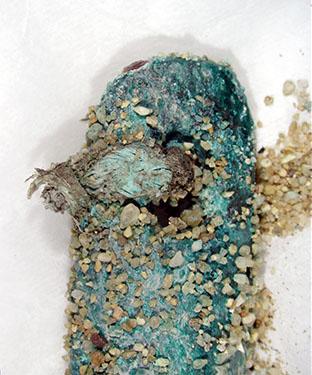Kunihiko Imai and Yosuke Akai
Source http://ajw.asahi.com/article/behind_news/social_affairs/AJ201508130067?
 String was found in a hole at the tip of the clapper of a "dotaku" bell unearthed in Minami-Awaji, Hyogo Prefecture. (Provided by the Nara National Research Institute for Cultural Properties)
String was found in a hole at the tip of the clapper of a "dotaku" bell unearthed in Minami-Awaji, Hyogo Prefecture. (Provided by the Nara National Research Institute for Cultural Properties)
Stirred and not shaken is how ancient bells may have been rung, researchers believe after discovering strings inside them for the first time in Japan.
“Some experts had insisted 'dotaku' (bells) made a sound by shaking them by hand, but the latest finding clearly shows they hanged from something when used,” said Yozo Nanba, director of the Center for Archaeological Operations of the Nara National Research Institute for Cultural Properties.
The strings were probably to hang the dotaku from tree branches, but also may have been used to set clappers inside the bells, according to the Aug. 12 announcement by the Hyogo prefectural education board.
The national research institute is currently CT scanning and dismantling two sets of small and large dotaku filled with sand. The bronze bells are among seven dotaku unearthed earlier this year in Minami-Awaji, Hyogo Prefecture, that date to the early to mid-Yayoi Period (300 B.C.-100 B.C.).
After removing sand from a set containing a 32-centimeter-tall dotaku and one standing 23 cm, researchers discovered traces of strings twisted around the crowns of the two dotaku. They also found remains of string in holes at the tip of the clappers, which measured 13 cm and 8 cm in length.
Organic substances that appear to be rotted strings were found in the sand as well. The researchers said the antibacterial effects of copper ions likely helped the string maintain its basic shape.
While two of the three discovered strings, which were wound around the larger dotaku’s crown and clapper and each measured two millimeters thick, are twisted cords, or torsades, made of plant fiber, the remaining one for the clapper of the smaller dotaku is a four-millimeter-thick braid.
Leaves were also found inside the two dotaku. They were apparently mixed in when the instruments were buried, the researchers said
The Nara research institute plans to determine when the dotaku were used and buried by analyzing the strings and applying carbon dating to them and the leaves. It will carefully dismantle the other set of dotaku at the same time.